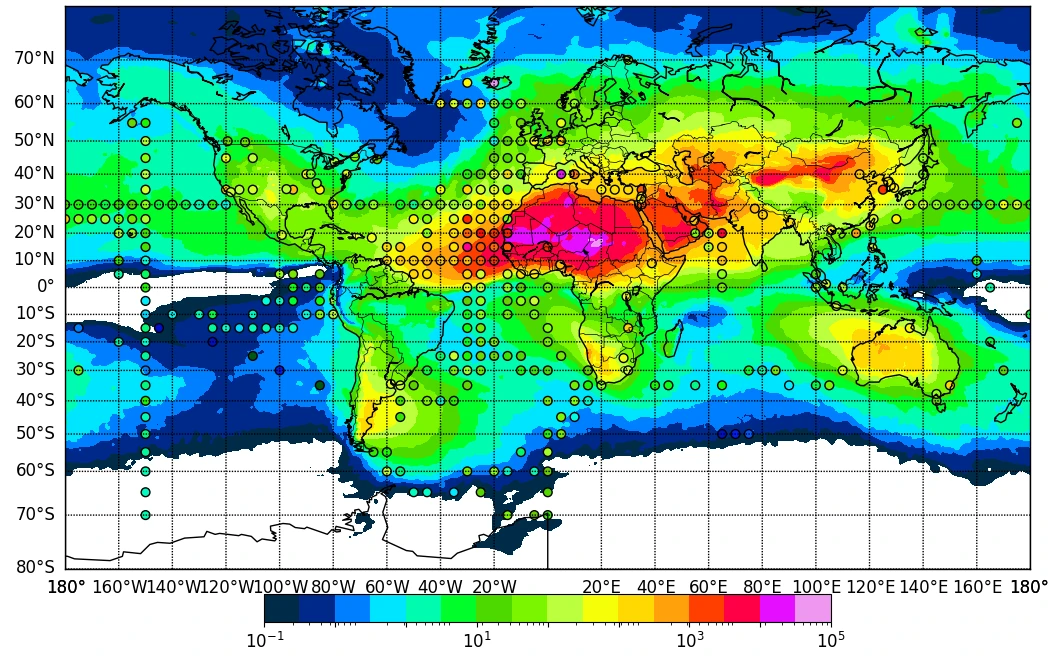
CAMS-related projects
CAMS provides both global atmospheric composition products, using the Integrated Forecasting System (IFS) of ECMWF, and regional European products, provided by an ensemble of nine regional models. HYGEOS co-leads with KNMI the CAMS2_35Bis project that requires experience and expertise in several domains: integrated global chemistry and aerosol modelling, physics and chemistry of the atmosphere, air quality modelling, as well as a detailed knowledge on the architecture and functioning of the IFS and of the possible observational datasets used for evaluation. CAMS2_35Bis acts as a continuation, until 31st March 2028, of the successful CAMS2_35 project (September 2021 to February 2025) which was also co-led by HYGEOS.
In this project, HYGEOS is in charge of the developments aiming at improving and extending all aspects of tropospheric and stratospheric aerosol modelling:
- implement operaionally developments from the CAMAERA project, such as a new dust emission scheme, dynamic ammonia emissions, fungal spores, etc,
- develop and test a version of IFS-COMPO to simulate the impact of a large volcanic eruption that could be used in an operational context,
- improve the coverage of the evaluation, especially for PM, and propose solutions for known issues such as the too simulated diurnal cycle,
- take over the CAMS ultra-violet processor and propose improvements,
- improve simulated deposition fluxes and propose further possible deposition products, such as iron deposition or others.

Simulated iron in PM2.5, in nanog/m3, for year 2019, versus observations from the SPARTAN network, as well as against climatological observations of iron surface concentration gathered in Myriokefalitakis et al. (2018). Output from experimental version of IFS-COMPO simulating dust mineralogy developed during the CAMS2_35 project.
R&D projects to prepare the CAMS evolution
HYGEOS leads the HORIZON Europe-funded CAMS AERosol Advancement (CAMAERA) project. It aims at providing strong improvements of the aerosol modelling capabilities of the regional and global CAMS systems, on the assimilation of new sources of data, and on a better representation of secondary aerosols and their precursor gases. In addition to the project coordination, HYGEOS contributes to the development of new desert dust and sea-salt aerosol emission schemes using machine learning approaches and to the intercomparison and evaluation of dry deposition models. HYGEOS also works on the Biogenic Volatile Organic Compounds (BVOC), precursor of the Second Organic Aerosols (SOA). A new BVOC emission module is developed and calibrated and its impact on simulated SOA is evaluated.

The overall goal is to enhance the quality of key products of the CAMS service such as PM2.5, PM10 and therefore help CAMS to monitor air pollutant. To achieve this purpose, CAMAERA develops new prototype service elements of CAMS, beyond the current state-of-the-art, and complements research topics addressed in CAMEO project.
HYGEOS participates also in the CAMS EvOlution (CAMEO) project, led by ECMWF, which contributes to the medium- to long-term evolution of the CAMS production systems and products. CAMEO tackles some challenges for enhancing the quality and service efficiency. These challenges are:
- a more accurate representation of the emissions and surface fluxes from anthropogenic and natural sources, vegetation and vegetation fires,
- an improved impact of assimilated satellite and in-situ observations on CAMS products
- the readiness to fully exploit the potential of earth observations from upcoming European satellite missions.
HYGEOS’s contribution focuses on deposition and on the quantification of the uncertainties of global products through an ensemble approach. First, it consists in better understand user requirements for deposition by different applications such as impact on solar collectors or agriculture. In second, HYGEOS develops user-specific validation protocol for deposition, defines priorities for validation and creates a database of validation data for deposition of dust, nitrogen and sulphur components with focus on non-European networks and initiatives. Then, HYGEOS performs demonstration study for a future regular validation of a global CAMS deposition product as potential addition to future CAMS operations. Finally, HYGEOS quantifies the uncertainty in global forecasts and studies the propagation of the uncertainty in meteorological parameters on the basis of an ensemble modelling. For that, the ensemble is extended with supplementary simulations that include emissions uncertainties and the use of different chemistry/aerosol dry and wet deposition schemes. The contribution of these two components on spread/uncertainty of CAMS products, in particular on deposition products, is assessed

